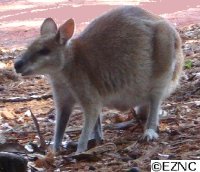The development of a joey in the pouch takes a long time, and the composition of the milk varies widely during this period. The protein content remains fairly constant, though the composition changes. The fat content varies from less than 15% (dry matter) to more than 60%, depending on the joey’s stage. The carbohydrate fraction also changes in terms of both content and composition. These changes make it impossible to speak of one milk substitute for young marsupials; various products are needed for the various stages. In Australia several brands market a variety of specialised products for marsupials, such as Wombaroo, Biolac and Di-Vetelact. Clear explanations about which product is for which stage of the young appear on these brands’ websites. This depends on hair distribution (bald or with fur), age and weight. It is essential that these stages are followed, as it’s absolutely not just a question of the degree to which the milk is diluted! The milk substitutes can be ordered in Australia. In an emergency (mother has died, joey needs milk but product has not been delivered), kitten milk can be used temporarily. However, this must be seen as a stop-gap measure: kitten milk is not a permanent substitute for nutritional products made specially for marsupials.
Stress prevention is very important for joeys’health. It’s best if they are cared for by only one handler and are protected from loud or shrill sounds. The pouch is their safe haven. If it becomes truly dirty (excrement, milk residue), it should of course be cleaned. However, the familiar scent is more important than an immaculate pouch.
Hand-rearing wallabies and kangaroos
24augustus2011
The EZNC regularly fields questions about hand-rearing marsupials, for example when a mother wallaby dies with young in the pouch and the owner wants to raise the young by hand.
